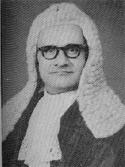| This article includes a list of general references, but it lacks sufficient corresponding inline citations. Please help to improve this article by introducing more precise citations. (February 2014) (Learn how and when to remove this message) |
| Bhuvaneshwar Prasad Sinha | |
|---|---|
 | |
| 6th Chief Justice of India | |
| In office 1 October 1959 (1959-10-01) – 31 January 1964 (1964-01-31) | |
| Appointed by | Rajendra Prasad |
| Preceded by | Sudhi Ranjan Das |
| Succeeded by | P. B. Gajendragadkar |
| Chief Justice of Nagpur High court | |
| In office 1951–1954 | |
| Preceded by | Prakash Chandra Tatia D. N. Patel (acting) |
| Judge of Patna High Court | |
| In office 1943–1951 | |
| Judge of Supreme Court of India | |
| In office 1954–1959 | |
| Personal details | |
| Born | (1899-02-01)1 February 1899 Shahabad, Bengal Presidency (Now in Bhojpur, Bihar, India) |
| Died | 12 November 1986(1986-11-12) (aged 87) |
Bhuvaneshwar Prasad Sinha of Shahabad (now Bhojpur), Bengal Presidency (1 February 1899 – 12 November 1986) was the 6th Chief Justice of India (1 October 1959 – 31 January 1964). He also served as the president of the Bharat Scouts and Guides from April 1965 to February 1967.
Sinha served as the Chief Justice of the Supreme Court of India from 1 October 1959 to 31 January 1964. Over the course of his Supreme Court tenure, Sinha authored 137 judgments and sat on 684 benches.
Life
Sinha was born and brought up in a prominent upper caste Hindu Kshatriya Rajput family of Rajwada Gajiyapur Estate, Arrah (present Bhojpur) District. His grandson B. P. Singh is a former judge of the Supreme Court of India.
A deeply religious man, following his retirement, Sinha led a quiet life mostly devoted to spiritual pursuits, though he did accept a number of private arbitration cases. Becoming blind in his later years, he died in 1986.
Career
He was educated at the Arrah Zilla School, Patna College and Patna Law College.
Sinha topped the list of candidates at the B.A. (Hons) in 1919 and M.A in 1921 at the Patna University. He was a Vakil in the Patna High Court from 1922to 1927. Later he became an advocate in 1927 and also got the position of Lecturer at the Govt. Law College, Patna, both of which he remained till 1935. He also was a member of the Senate of the Faculty of Law and of the Board of Examiners in Law, Patna Univ. He became the member of the Court of the Benaras Hindu University where he was a Government Pleader from 1935 to 1939. He was Srimati Radhika Sinha Gold Medalist for standing first in History.
He became an Assistant Govt. Advocate in 1940 and the Judge of Patna High Court in 1943. He was elevated to the position of the Chief Justice of Nagpur High Court in 1951 and eventually to the Judge of Supreme Court in December 1954 at which he remained till September 30, 1959. He finally became the Chief Justice of India in 1959 and remained so till 1964 and then he retired.
Published works
- Reminiscences and Reflections of a Chief Justice ISBN 81-7018-253-0, 1985, 1st ed.
References
- "B.P. Sinha". Supreme Court Observer. Retrieved 30 September 2024.
- Gardbois Jr., George H. (2011). Judges of the Supreme Court of India 1950-1989. Oxford University Press. pp. 20–30. ISBN 978-0-19-807061-0.
- "Chief Justice & Judges | SUPREME COURT OF INDIA". main.sci.gov.in. Retrieved 3 May 2022.
- Supreme Court of India, Biographies
| Legal offices | ||
|---|---|---|
| Preceded bySudhi Ranjan Das | Chief Justice of India 30 September 1959 – 31 January 1964 |
Succeeded byP. B. Gajendragadkar |
| Preceded byAmmu Swaminathan | Presidents of the Bharat Scouts and Guides 1965–1967 |
Succeeded bySir Chandulal M. Trivedi |
This Scouting or Guiding article about a person is a stub. You can help Misplaced Pages by expanding it. |
This Indian law–related biographical article is a stub. You can help Misplaced Pages by expanding it. |
- 1899 births
- 1986 deaths
- Chief justices of India
- Scouting and Guiding in India
- Patna University alumni
- People from Patna
- Judges of the Patna High Court
- Chief justices of the Madhya Pradesh High Court
- 20th-century Indian judges
- 20th-century Indian lawyers
- People associated with Scouting stubs
- Indian law biography stubs